Tag Archive for: Rain Garden
Rain Capture Sanctuary
Priorities: Rainwater Catchment – Outdoor Seating – Native Plantings
Challenges: Expansive Grass Lawn
Solutions: Channel Rainwater to Cistern and Rain Garden – Install Patio – Terrace and Grade Area
This cistern, rain garden, and patio project functioned as an example of mutual inspiration. Maas Verde’s nature-centric client helped us reframe our own thinking about rain gardens. And in turn, we helped her vision become a lush, rain-collecting, native planted reality.
A small shady spot below a tall pecan tree overlooked a gently sloping turfgrass lawn. It was a natural seating area, and the installation would revolve around it.
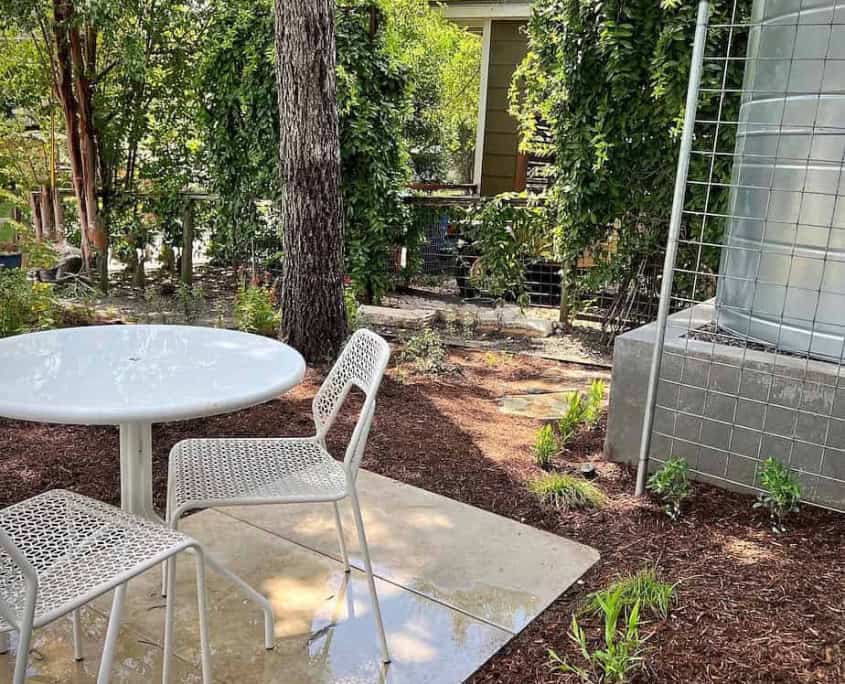

The plan incorporated a 20’ x 10’ rain garden swale with berms, native karst limestone boulders, a 1,000-gallon galvanized cistern, and 317 native plants representing 17 species. This and a honed limestone patio would partially replace the Zoysia grass lawn. Advantageously, we were able to repurpose some materials from the site: ¼” steel edging and part of a limestone block wall encircling the tree.
Maas Verde built an 8’ x 8’ CMU (concrete masonry unit) pad for the cistern to stand on. To match the block walls to the house foundation, the crew finished the surfaces with stucco. A 5-foot pony wall helps divide it from the side yard. A galvanized pipe trellis helps screen and cool the tank, once native coral honeysuckle plantings are established.
The rainwater catchment system works via collection and cascade. First, piping funnels rainwater from the roof into the tank. When the tank overflows, it disperses into the rain garden below. Finally, a gentle channel cut into the garden and adjacent limestone wall allows any water still moving downhill into the lawn.
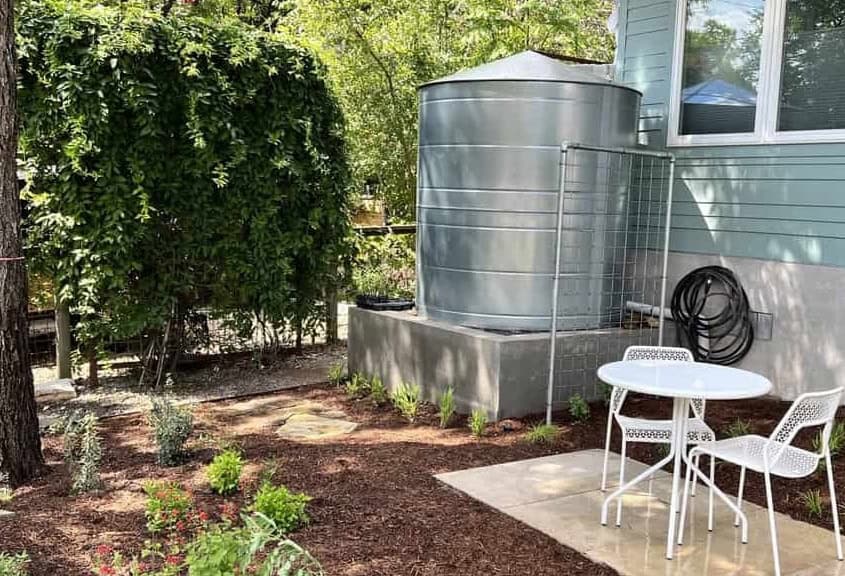
The system handles a surprising capacity of water. Together, the cistern and garden can hold 1,980 gallons. That’s enough to fill about 45 bathtubs to the brim. In a 1” rain event, the client’s roof would collect 840 gallons of rainwater.
Maas Verde’s system only needs to capture a fraction of that to sustain its hearty native plantings. The outdoor seating component adds novel functionality to the space.
“Most people don’t think of rain gardens as landscapes that are particularly geared toward humans. They’re considered more like ecologically-focused elements than practical spaces for people to hang out,” Maas Verde project manager John Harris explained. “But this design proved, any rain garden can be both at the same time.”
Anderson Mill
Priorities: Stormwater Management – Native Hill Country Landscape – Reduced Maintenance
Challenges: Sidewalk Pooling – Heat-Exposed Yard – Invasive Plants
Solutions: Rain Garden Swales – Limestone Masonry – Turf Removal and Native Plantings
This Northwest Austin landscape renovation addressed chronic stormwater pooling along the front sidewalk while revitalizing an aging, sun-exposed yard. The removal of a mature Arizona ash had left the landscape bare and overheated, while invasive nandina and ligustrum dominated the remaining beds. The clients envisioned a native Hill Country aesthetic—lush flowering perennials nestled among limestone outcrops—and shared images to guide the design.
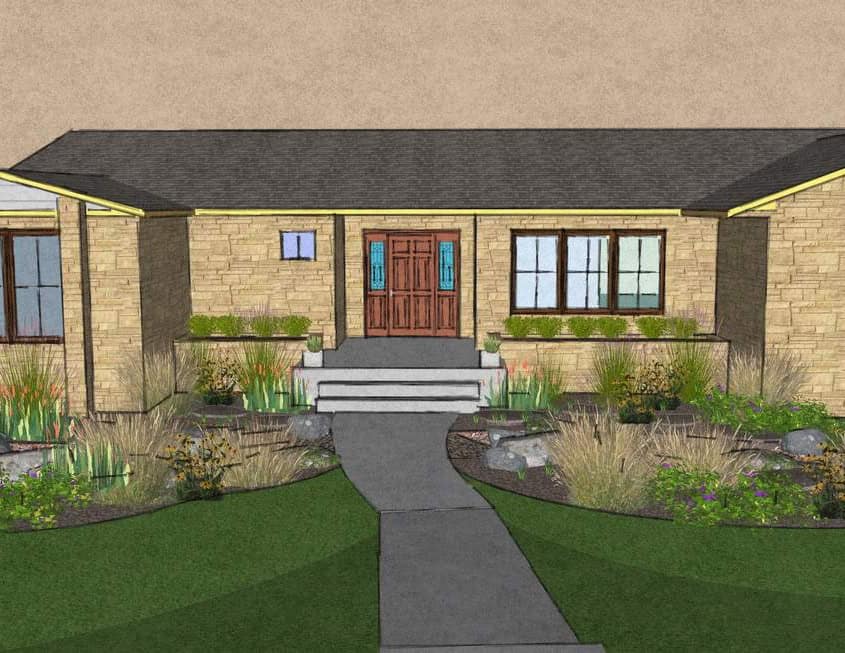
The project focused on three core goals:
- Resolving the sidewalk pooling issue.
- Refreshing overgrown and unsightly areas.
- Reducing maintenance by removing turf grass.
To manage stormwater, Maas Verde excavated two rain garden swales totaling 330 square feet on either side of the front sidewalk. Front downspouts were redirected into the swales, allowing them to capture runoff from both the roof and sidewalk. Together, the rain gardens can hold approximately 1,270 gallons of water, capturing nearly 990 gallons during a one-inch rain event. This stored moisture improves soil health and supports plant establishment while preventing runoff from reaching the sidewalk.
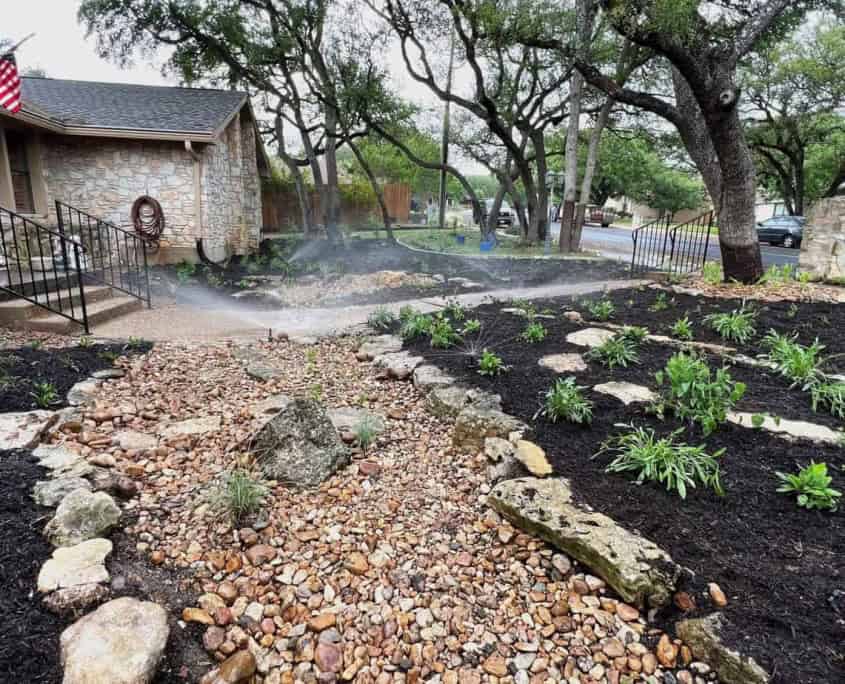
Masonry elements played both functional and aesthetic roles throughout the project. Hill Country limestone was used to line the rain gardens, and strategically placed stepping-stone paths improve access while reinforcing the natural character of the landscape.
To further reduce maintenance, 1,905 square feet of St. Augustine turf grass were removed and replaced with mulched planting beds. The renewed landscape was planted with 640 native plants representing 29 species, creating a resilient, water-wise front yard that reflects the clients’ Hill Country vision while solving long-standing drainage issues.
Rain Garden Fix for Drainage, Access and Inviting Backyard
Priorities: Ecological Drainage – Accessibility – Low-Maintenance Landscape
Challenges: Misgraded Runoff – Limited Foot Traffic – Turf Berms
Solutions: Rain Garden Swales – Limestone Walkways – Turf Removal and Native Plantings
This residential landscape project solved long-standing drainage issues while transforming both the front and back yards into accessible, low-maintenance outdoor living spaces.
In the front yard, improper grading caused rainwater to backflow onto the driveway and pool in pedestrian areas during storms. An adjacent lawn berm prevented drainage, limiting safe foot traffic—especially for the homeowners’ aging parents. Maas Verde removed the existing concrete sidewalk, regraded the site toward a central collection area, and installed a wider sidewalk and expanded patio using sawed limestone slabs to improve circulation and usability.
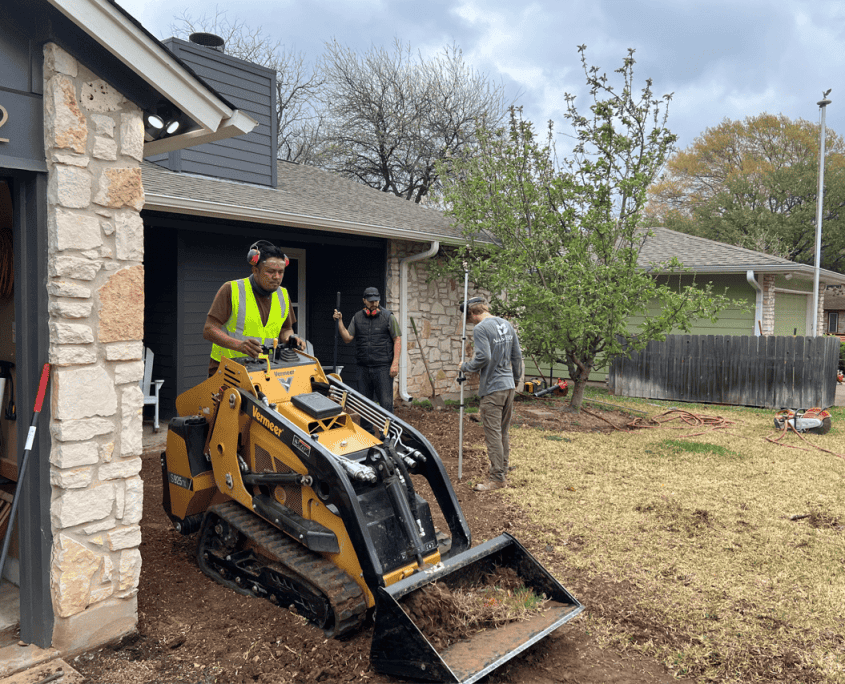
To manage stormwater ecologically, the grass berm was removed and replaced with a 200-square-foot rain garden swale designed to capture runoff from surrounding stonework and impervious surfaces. During a one-inch rain event, the system can capture approximately 540 gallons of runoff and hold up to 990 gallons in total capacity. More than 650 square feet of St. Augustine turfgrass were removed in the process and replaced with a diverse planting of 317 native plants representing 12 species, helping absorb moisture while creating a resilient, water-wise landscape.
Eighteen months after installation, the rain garden has matured into a thriving native habitat. Maintained using only rainfall and Stage 2 irrigation restrictions (one day per week), the space now supports hummingbirds, bumble bees, and even occasional wildlife visitors like a fox.
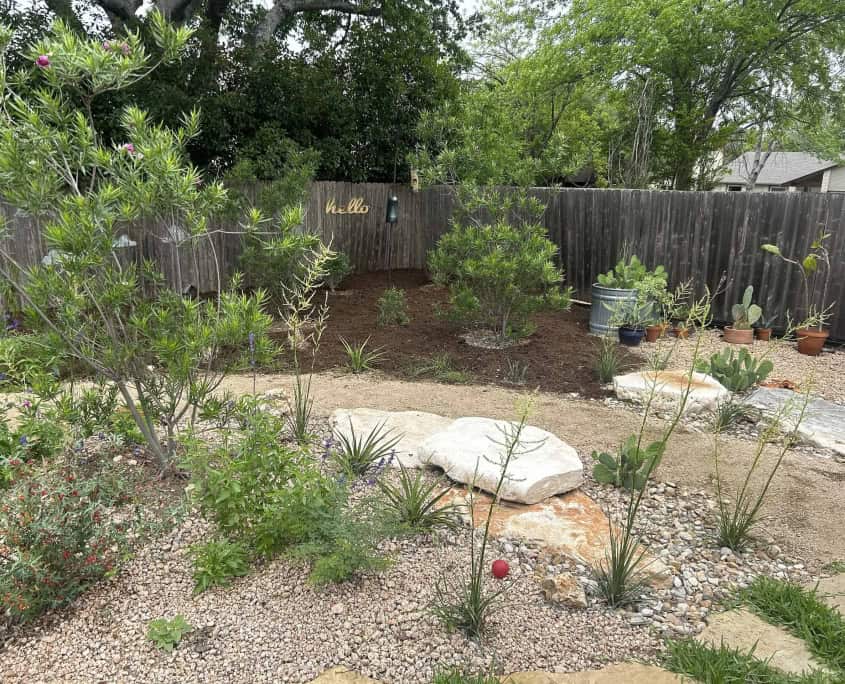
In the backyard, the goal was to create an inviting, low-maintenance gathering space as an alternative to a high-input lawn. Maas Verde removed an additional 2,700 square feet of St. Augustine turfgrass and replaced it with a gravel walking path that connects multiple garden sanctuaries. The existing concrete porch was extended and resurfaced with 2-inch-thick cut limestone, creating a functional outdoor living and grilling area.
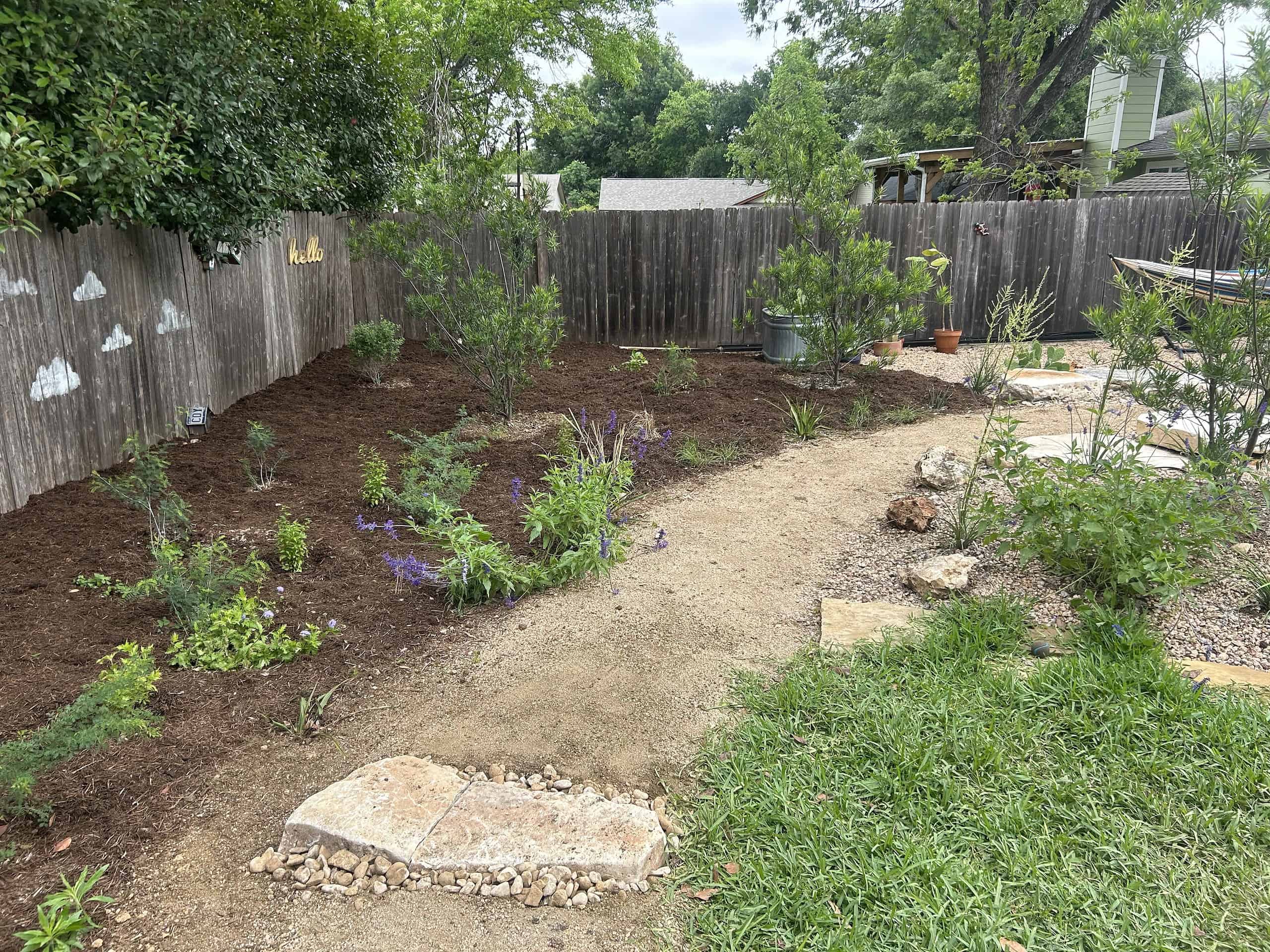
The backyard plant palette includes 26 native species, alongside features such as stacked pancake boulders, cream limestone slabs, a Desert willow, wildflower meadow, and succulent garden. Together, the front and back yard improvements form a cohesive landscape that prioritizes ecological performance, accessibility, and year-round enjoyment.

